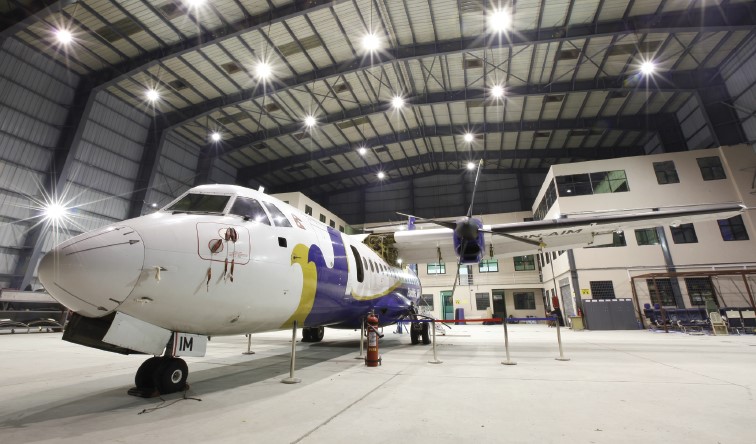Even before any flight takes off, there are many operations that need to come together so that passengers can fly to their destinations. While passengers can see the efforts of the airport and ground employees, the work of the technicians and engineers at the hangar often go unnoticed. Without a hangar or the people working there, air travel would not be the safest mode of travel that we know today.
During the early years of flight, hangars were merely used as storage sheds. As commercial aviation became a reality, it was imperative that passengers and flight crew could safely fly the skies. Now, hangars are used for maintenance, repair and overhaul (MRO). These hangars maintain the aircraft in an airworthy condition for the safety of the passengers and crew.
Buddha Air’s International Standard Hangar

Working at the 37,000 square feet hangar space are the technicians and engineers of Buddha Air. Located across the runway from the Tribhuvan International Airport, the closed door hangar facility is the first of its kind in Nepal. The 280-ton steel structure was built at a cost of US$ 2.5 million and its inauguration was on 18 April 2012. Buddha Air is also the first airline in Nepal to obtain an operation certificate to provide MRO services from the Civil Aviation Authority of Nepal (CAAN). Besides maintaining its own aircrafts in an airworthy condition, Buddha Air also provides MRO services to other airlines like NOVOAIR and Druk Air.
There are broadly two types of maintenance that any aircraft operated by Buddha Air goes through; line maintenance and base maintenance. Line maintenance is the day-to-day routine checks and inspections that an aircraft undergoes. For base maintenance, an aircraft will not operate within a scheduled timeframe. Base maintenance includes ‘A’ Checks, ‘C’ Checks, 2 yearly inspections, 4 yearly inspections, 36,000 cycle threshold inspection, 200-hour detailed inspection, etc. Such maintenance requires special tools and requirements – and Buddha Air’s hangar has over US$10 million worth of aircraft spares inventory. The hangar also has well-stocked and updated support shops like wheel and a brake shop, battery shop, sheet metal shop, etc.
As per Nepal’s Civil Aviation Regulation, Buddha Air’s technical department has two main functions; Approved Maintenance Organization (NCAR -15) and Continuing Airworthiness Department (CAD). Each type of aircraft operated by Buddha Air comes with its own maintenance manual - which is strictly adhered to during checks and inspections.
Keeping You Safe in the Air
With every Buddha Air flight, a certified line technician will first check an aircraft maintenance statement. He will verify if any components are due for inspection or change. He will also check if any defect has been reported from the previous flight and ensure that corrective measures are taken.
These certified engineers and technicians work on every part of Buddha Air’s fleet, which includes two Beechcraft 1900D, three ATR 42-320 aircrafts and five ATR 72-500 aircrafts. They have already passed stringent exams to be certified to maintain the aircrafts. Furthermore, engineers and technicians undergo regular training to refresh and update their skills and knowledge.
All of Buddha Air’s aircrafts have to pass a daily preflight and post-flight checklist - which is a visual inspection to look for obvious damages. The technician will do a walk around of the aircraft to see if any superficial damage can be seen in the airframe. He will also do a general visual inspection of the wing, fuselage area and propeller blades. Signs of fuel leaks, hydraulic leaks, tyre conditions and landing gear extensions of the aircraft are checked thoroughly.
Every inspection and check is followed by paperwork and records, which are updated by the Technical Records section. Employees are responsible for keeping day to day records of aircrafts’ hours and cycles, status of major aircraft components (engine, propeller, landing gear) log book of airframe and engine, schedule inspection status, etc. A computerized system and allocated servers in different places ensure there is no leak or loss of crucial data.
All these checks and inspections are preventive measures undertaken by Buddha Air. The technical and engineering departments do not wait for problems to happen to fix them. Rather, they follow instructions given by the manufacturer to keep all aircrafts in an airworthy condition. Furthermore, Buddha Air has taken additional steps to ensure passenger and crew safety. It has developed a customized maintenance program based on the manufacturer’s data which is approved by Civil Aviation Authority of Nepal.
Every time you board an aircraft, remember all the work that goes on behind the scenes to make your flight safe. Buddha Air’s technicians and engineers are busy at work ensuring your journey in the skies is safe.













